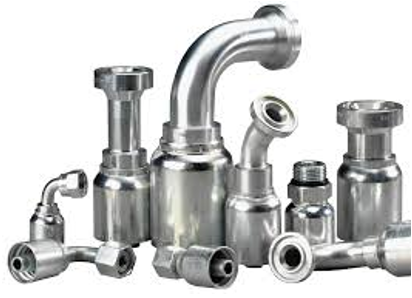Five Factors to Consider when Choosing Hydraulic Fittings

Hydraulic systems have been evolving rather fast as engineers work on variations to deliver higher efficiency. Gone are the old days of only NPT and JIC as newer fitting versions such as JIS, BSPP, GAZ, DIN fittings, and ORFS hit the market. Engineers and fitting manufacturers are working extra hard to create new end connection types to work with modern hydraulic systems. This post brings you the main considerations when selecting hydraulic fittings.
A Closer Look at the Common Hydraulic Fittings
Before delving into the factors to consider when selecting hydraulic fittings, it is important to understand the different types in the market.
- O-Ring Face Seals: O-Ring face seal fittings are designed with flat sealing surfaces with embedded seals that mate to flanged hose fittings. Flat sealing surfaces are used to help reduce the danger of over-torquing. It also helps to prevent leakage.
- JIC 37” Flares: The Joint Industrial Conference fitting is one of the common hydraulic connection types in the industries today. It is fitted with parallel threads and a 37-inch cone on one end that attaches to the hose fitting or flared tube.
- Inch Compression: The inch compression fitting is a bite-type of fitting for hydraulic tubing. The fitting can be fitted into hydraulic tubing with minimal tooling need. However, there are very limited connections in this style.
- NPT Pipe Threads: NPT threads feature the traditional tapered threads and available in brass and iron for the low-pressure and stainless steel for the high-pressure options.
- DIN Metric 24” Bite Type: This fitting is very common in Europe. It can be used with metric size tubing while the latest versions feature elastomeric seals for better sealing on the mating surface.
Factors to Consider When Selecting Hydraulic Fittings
Now that you know the main types of hydraulic fittings, here are the main factors to consider when selecting one for your system:
- Versatility: JIC fittings provide higher versatility compared to most fitting systems listed above. In addition, there are fittings that can easily connect JIC to a foreign port or jump sizes (expand or reduce) between the main sizes. One benefit of JIC is that it is available in different variations such as elbows, straights, and long drops. It is also stocked by most vendors.
- Availability: NPT and JIC fittings were considered the field standards for many decades. Therefore, they are readily available in many varieties and volumes. As OEMs convert to DIN metric fitting and O-ring face seals, it implies that you can easily find them in most hydraulic shops.
- Pressure Rating: Most OEMs are opting for DIN metric fittings and O-rings face seals because they can handle higher pressure ratings. But NPT threads are not recommended for high-pressure operations.
- Application: The application that a fitting will be used in is crucial when selecting a hydraulic fitting. Here, you need to factor operational parameters such as size, temperature, media, and pressure when selecting the right fittings. It is important to also check the manufacturer’s catalog for respective fittings.
- Reliability: The most popular threads are those in the NPT pipe because leaks can be fixed easily. But this process often results in the formation of cracks. Its reliance on Teflon tape can also result in contamination. Besides, the JIC is also prone to cracked flares from excessive wrenching. This is why the mated sealing surfaces on the O-ring face seal and DIN metric fittings are considered more reliable. They also help to lower the risk of over torquing because of the elastomeric seal.
To get more from your industrial system, it is prudent to ensure that all the hose pipes are done properly. This post provides the top five hydraulic fittings and tricks for selecting the best for your system.
